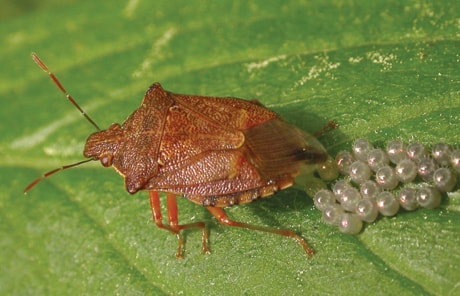Even when they’re not crushed, or feeling threatened, stinkbugs really do smell. And the brown-green Asian imports can pack a dangerous punch for anyone who has a sensitive nose or lungs.
The shield-shaped bugs have been around for two decades, apparently originating from a container shipped into eastern Pennsylvania in the late ’90s. The bugs have been particularly prolific in the Mid-Atlantic states lately, but there are reports of the invasive species turning up in more than 20 states.
Although considered a nuisance when they invade households in the fall to hibernate and a bane to fruit orchards, stinkbugs had not been considered hazardous to humans since they don’t sting, bite or carry any known infections.
But their loud buzzing flights and propensity to hide out in closets, sunny walls and to get active whenever they get warm have not earned them warm welcome.
Only with the recent heavy outbreak from Virginia to New York have allergists started to consider the respiratory irritation potential of the critters. Many people are allergic to insects such as dust mites, cockroaches and ladybugs.
“We expect stinkbugs are also a significant allergen, given their increasing prevalence in many areas,’’ said Dr. Faud Ishmael, an allergist at Penn State Hershey Medical Center. At the request of the Allergy and Asthma Network/Mothers of Asthmatics, a national nonprofit support group, he’s working with colleagues to quantify how many people have immune systems that ramp up from stinkbugs.
“About half the patients I’ve asked say they have nasal allergy and asthma symptoms when around the bugs,’’ Ishmael added. He’s conducting a more formal survey of patients with symptoms now.
He also is working to characterize distinctive proteins from the insects and hopes to be able to create a stinkbug extract that can be used for sensitivity screening and perhaps allergy shots.
Meanwhile, homeowners and orchardists alike are looking for solutions to kill stinkbugs. Experts differ on how susceptible they are to pesticides, and there are concerns about spraying apples, peaches and the like too heavily or using heavy-duty toxins to treat the insides of home walls, attics and other favorite insect hiding spots.
A number of pest control companies offer to put chemical barriers around homes to keep stinkers from coming in, but some bug scientists say the treatments may not be as effective as hand-to-hand combat with the bugs (removing them one at a time) once they get inside.
Last fall, Japanese researchers reported they were making progress in developing a commercial repellent against stinkbugs, which are also major threats to rice crops there and in other Asian nations.
The scientists at Tattori University said they have determined that a fungus that grows inside foxglove plants is about 90 per cent effective in turning away another breed of stinkbug. They recently reported in the Journal of Agriculture and Food Chemistry that an extract of the fungus worked as well as naphthalene, the active ingredient in mothballs, at driving away stinkers.
While spring brings stinkbugs out of hibernation, it also sprays the countryside with pollen.
Researchers presenting their findings at the annual scientific meeting of the American Academy of Allergy, Asthma and Immunology (held in San Francisco in mid-March) cautioned that many Web and broadcast sites that forecast pollen counts often get the numbers wrong. They compared the predictions to actual counts done by the academy’s members using air sampling equipment and microscopes to count grains of pollen in cities across the U.S. and Canada.
The scientists said that patients should be wary of relying on the forecasts in deciding how much time to spend outside or what preventive medicines to take to ward off allergy and asthma attacks.
“Predicted counts reported on many websites may be based on pollen data from previous years and general weather forecasts,’’ said Estelle Levetin, head of the academy committee that oversees the National Allergy Bureau. “Pollen counts from the NAB stations are based on actual counts which reflect real day to day weather events.”
The reports are posted daily during allergy seasons at www.aaaai.org/nab.
